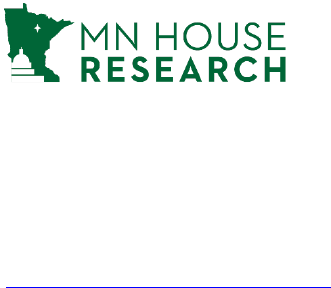
Dangerous Dogs in
Minnesota
August 2024
State law regulates dangerous dogs
Minnesota Statutes, sections 347.50 through 347.565, address the regulation of dangerous dogs. The
1988 Legislature created the classification and established requirements for owning a dangerous dog.
Current law allows owners to petition for review of the dangerous dog designation, requires that
dangerous dogs be implanted with a microchip for identification, specifies the amount of coverage
owners must carry to reimburse a person who suffers personal injuries caused by a dangerous dog, gives
the animal control authorities enforcement authority, establishes the requirements related to the
disposition of seized animals, creates an ownership prohibition for certain people, includes enhanced
penalties for subsequent violations, and lists the situations in which a dog could be destroyed.
Actions, not breeds, can result in a dog being designated “dangerous” or
“potentially dangerous”
A “dangerous dog” is one that has:
1) without provocation, inflicted substantial bodily harm on a human being;
2) killed a domestic animal without provocation while off the owner’s property; or
3) aggressively bitten, attacked, or endangered the safety of humans or domestic animals after
the owner has notice that the dog was found to be potentially dangerous.
A “potentially dangerous dog” is one that:
1) unprovoked, bites a human or domestic animal;
2) chases or approaches a person on a street that is not the owner’s property in an apparent
attitude of attack; or
3) has a known propensity to make an unprovoked attack that threatens the safety of humans
or domestic animals.
The local animal control authority is the only entity that can designate a dog as being “dangerous” or
“potentially dangerous.” Some jurisdictions have a specific animal control office while others give the
authority to another entity—usually the local law enforcement agency.
Owners must meet several specific requirements to keep a dangerous dog
Minnesotans can own dangerous dogs, but must register the dog with the local animal control authority,
which can include an annual fee of up to $500 in addition to any regular licensing fees, and show an
animal control authority that:
1) the owner has a proper enclosure with a warning sign and symbol;
2) the owner has either a surety bond or liability insurance in an amount of at least $300,000
to cover any personal injuries inflicted by the dog; and
3) the dangerous dog has had a microchip implanted.
Following registration, an owner must:
1) keep the dog in a proper enclosure while on the owner’s property and muzzle the dog while
off the property;

Dangerous Dogs in Minnesota
2) renew registration annually;
3) within 30 days, notify animal control of the death of the dog or its transfer to a new
location;
4) pay for the sterilization of the dog;
5) before renting property, inform the property owner of the dog; and
6) if transferring the dog, notify the new owner that the dog is identified as dangerous and
inform animal control of the new owner.
Police dogs and dogs acting in defense cannot be designated as dangerous
A dog is not subject to registration if it is used by law enforcement officials or if it: (1) attacked a person
trespassing on the owner’s premises; (2) was provoked or abused at the time of the attack or repeatedly
before the attack; or (3) attacked a person committing or attempting to commit a crime.
At times, local animal control authorities can confiscate dangerous dogs
If an owner fails to comply with the dangerous dog requirements, the local animal control authority can
seize the dog. An owner has seven days to show compliance with the requirements and reclaim the dog.
The animal control agency must seize a dog if an owner is charged with a new offense after being
convicted of violating the dangerous dog ownership requirements relating to the same dog. If the owner
is convicted of that new offense, the animal control agency must destroy the dog. In addition, the
authority may destroy a dog that:
1) inflicted substantial or great bodily harm on a person without provocation;
2) inflicted multiple bites on a person without provocation;
3) bit multiple people in the same attack without provocation; or
4) bit a person in an attack where more than one dog participated.
Owners can challenge a dangerous dog designation
An owner has the right to a hearing. The authority declaring the dog dangerous must give a notice that
identifies the dog, describes the reason for the declaration, and explains the right to appeal. Within
seven days of seizure, the owner must post a security in an amount sufficient to provide for the dog’s
actual cost of care and keeping. The hearing must be held within 14 days of the request and the hearing
officer must issue a decision within ten days. If the decision is upheld, the owner is responsible for up to
$1,000 of the costs of the hearing.
Local governments can pass additional restrictions on dogs
Local governments are authorized to regulate dangerous dogs in a more restrictive manner than state
statute, but dogs may not be considered dangerous or potentially dangerous based solely on their
breed.
There is no central database tracking dangerous dogs
Individual animal control authorities are responsible for registration procedures, but there is no central
database of dangerous dog statistics. Some cities, including Minneapolis, make information about
dangerous dogs living within city boundaries available online.
Minnesota House Research Department provides nonpartisan legislative, legal, and
information services to the Minnesota House of Representatives. This document
can be made available in alternative formats.
www.house.mn.gov/hrd | 651-296-6753 | Third Floor, Centennial Office Building | St. Paul, MN 55155
